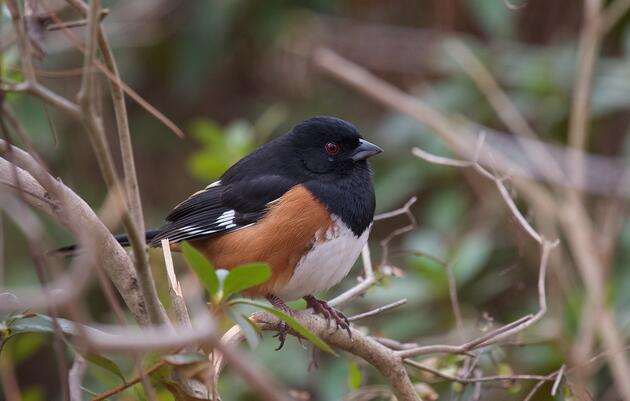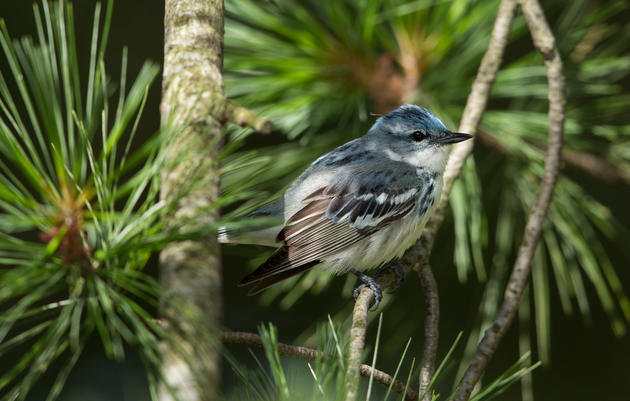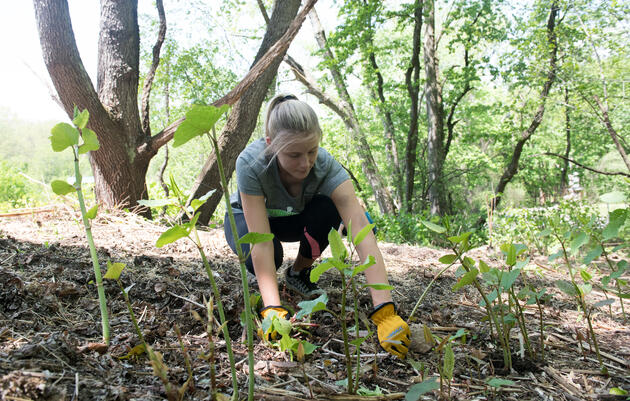FALL, 2020 -- Bird banding is a powerful conservation tool that enables scientists (and community scientists!) to track the movements and patterns of individual birds. Banding data also helps with analyzing populations of species.
Corrie Folsom-O’Keefe, Audubon Connecticut’s Director of Bird Conservation, runs the bird banding station at the Bent of the River Audubon Center in Southbury, CT. Several of the species that have been captured and banded from 2013 – 2019 are forest-dwelling birds, known to nest in mature forest habitat. At this particular bird banding station, the nets used to safely capture birds are placed in open, shrubby meadowlands. Despite this area being very young forest, Worm-eating Warbler, Ovenbird, Red-eyed Vireo, and a few other mature forest birds have all been captured and banded here. This confirms what we know to be true: birds that nest and raise their young in the woods depend on a healthy and diverse habitat.
The Bent of the River Audubon Center is surrounded by more than 500 acres of mature forests, which is likely where these species breed and spend the majority of their time. However, because of the frequency of their being captured at the banding station, which is within much younger, shrubbier habitat, we can infer that they are also spending time in this habitat type as well. The younger forest area is critical for offering more sunlight, and in turn more fruit and insects—valuable food sources.
“Small State, Big Responsibility”
Northwest Connecticut and its neighboring northern states support the highest population densities of breeding birds in the continental U.S. Many of these birds are “neotropical migrants,” meaning that they come to our state specifically for the insect-rich breeding habitat and longer daylight hours. Despite the availability of this habitat, Breeding Bird Survey data shows that over 40% of all neotropical bird species are facing population declines in our region.
Breeding forest birds require very specific tree cover, understory and midstory vegetation, and often some woody material (downed deadwood or snags) for nesting, but they may need to travel to find adequate food to feed their voracious nestlings. This often is not all found within one forest type, and like the forest birds observed at the Bent of the River Audubon Center, many species take advantage of the wealth of food found in young forest habitat.
“This is also true during migration” explains Corrie Folsom-O’Keefe, Director of Bird Conservation. “This fall, we captured a good number of thrush in the nets, including locally breeding Wood Thrush, but also Swainson’s, Grey-cheeked, and Hermit Thrush that breed to our North.”

Unfortunately, the most abundant type of habitat in Connecticut and the surrounding region is middle-aged forest, so there is a shortage of younger habitat. Management practices that diversify the forest's age structure, will also help diversify bird species.
The Importance of Bird-Friendly Forest Management
Forest birds are facing significant decline. Although many of the threats birds face—due to climate change and other factors—may feel out of our control, there are tangible ways that forest landowners can manage this habitat to benefit birds and the overall forest ecosystem.
Over 80% of the forested land in Connecticut is privately owned, which is why it is critical that Audubon Connecticut is able to partner with these landowners to make an impact. To assist landowners in the management of woods, Audubon also trains foresters in managing forests with birds in mind. Keep an eye out for a list of Audubon “endorsed” foresters in 2021.









